|
Tule
Ponds at Tyson
FISH |
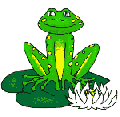 |
|
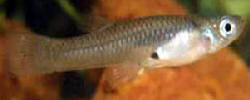 Western Mosquito Fish Western Mosquito Fish
Gambusia affinis
This small fish has a
short flattened head and rounded tail. It feeds on larvae of
mosquitoes and other insects. It bears its young live unlike many
fish. Mosquito fish have been introduced around the world for
mosquito control. Unfortunately, they are aggressive and replace
native fishes in some areas. |
|
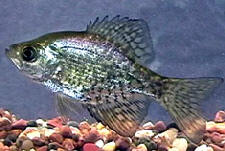 Black crappie Black crappie
Family Centrarchidae (sunfish)
Pomoxis nigromaculatus
Back
is dark olive, metallic green to golden brown. Their dorsal, tail,
and anal fins are strongly reticulated with black giving the
appearance of a dark-colored fin with many whitish spots. Large
mouth with an upper jaw extends well past middle of eye when mouth
is closed. Lives for 8-10 years. |
|
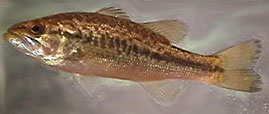 Largemouth bass Largemouth bass
Family Centrarchidae (sunfish)
Micropterus salmoides
Common name from
large mouth, the line of which extends back past the eye Though
tolerant of turbid water, it favors lakes with clear water, sandy
shallows, and abundant rooted aquatic weeds; also slow moving rivers
or streams with soft bottoms. Many species of pondweeds, water
lilies, elodea, cattails, and bulrushes provide excellent cover. A
"warm-water" species, it flourishes in waters warmer than 80º F. and
can survive temperatures into the mid-90's. |
|
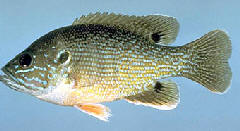 Green sunfish Green sunfish
Family Centrarchidae (sunfish)
Lepomis
cyanellus
Green sunfish
have a short, wide head, deep body with a big mouth. Its dark gill
flap is rimmed in yellow or white. Back color is brownish, olive to
blue green with an yellow underside. Can tolerate extreme aquatic
conditions. |
|
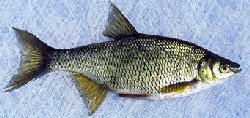 Golden shiner Golden shiner
Family Cyprinidae
Notemigonus crysoleucas
Shiners are
active fish that swims in a loose school from the bottom. They feed
from midwater to the surface on adult and immature states of
cladocerans, midges, dragonflies, beetles, water mites, filamentous
algae and mollusks. The golden shiner begins to spawn when the water
temperature reaches the high 60s and continues laying eggs through
late summer. |
|
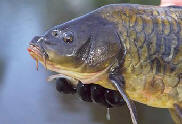 Carp Carp
Family
Cyprinidae
Cyrinus carpio
Carp prefer
warm, slow-moving rivers, lakes, ponds and impoundments with muddy
bottoms and lots of vegetation. They often thrive in degraded areas,
such as urban waterways, where native fishes cannot survive. Carp
can tolerate low oxygen levels, very high or low water temperatures,
and turbidity. They are omnivores, ingesting mouthfuls of bottom
sediments and expelling them into the water, and then eating the
insects, crustaceans, worms, aquatic plants and algae contained in
the sediment. |
|
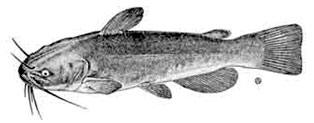 Brown bullhead Brown bullhead
Family Ictaluridae
Ictalurus nebulosus
The brown
bullhead is a medium size member of the catfish family, generally
measuring 8 - 14 inches in length. This species requires a shallow
nest for spawning, often building a burrow alongside a stump, rock,
or tree. Eggs in the nest are cared for by both parents. About 7
days after hatching, the young leave the nest in a loose school
consisting of hundreds of baby bullhead; this school is normally
accompanied by one or both of the parents. |
|
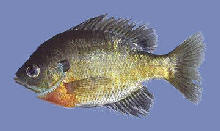 Bluegill Bluegill
Family Centrarchidae
Lepomis macrochirus
Blue gills tend
to overpopulate warm waters which leads to stunted growth rates and
large populations of small fish. They feed primarily on insects, but
will also eat crustaceans, fish eggs, very small fish and aquatic
vegetation. Bluegills feed most actively when water temperatures
reach 81 degrees Fahrenheit. Like all sunfish, the bluegill breed in
the spring in shallow, saucer-shaped nests scooped out by the males.
They usually concentrate their nests in colonies. Then males round
up one or more females and bring them to the nest to lay eggs. |
|